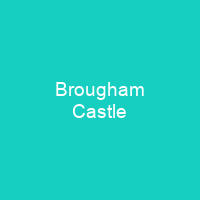Brougham Castle: A Time Capsule in Stone
Imagine stepping back into the Middle Ages through the gates of Brougham Castle, a medieval gem nestled in the heart of Cumbria, England. This castle, founded by Robert I de Vieuxpont in the early 13th century, has witnessed centuries of history, from Roman fortifications to the Wars of Scottish Independence and beyond.
When Angles arrived in the area, they named it Brougham, meaning ‘the village by the fort.’ Between the end of Roman rule in the early 5th century and the Norman Conquest in the late 11th century, Cumbria was a turbulent area. In 1092, William II captured Cumbria south of the Solway Firth and established a new border far north of Brougham. The site at Brougham remained unfortified until Robert I de Vieuxpont chose it for his castle.
Founding and Early Years
In 1203, the Barony of Westmorland was granted to Robert de Vieuxpont by King John. Around 1214, he asserted control over more land, including half the manor of Brougham. The castle’s earliest form consisted of a stone keep, an earthen bank, and a wooden palisade. Building in stone was expensive and time-consuming, but Vieuxpont’s control over the king’s revenues from Cumberland helped fund the construction.
Construction would have been suspended during the invasion of Scotland in 1216, but resumed after Alan of Galloway retreated in 1217. When Robert de Vieuxpont died in 1228, his only son John was a minor and his property was taken into wardship. The estates fell into disrepair, including Brougham Castle.
Clifford Family Rule
In 1257, Robert de Vieuxpont came of age and inherited considerable debts. He revolted against King Henry III in the Second Barons’ War but died as a traitor in June 1264. His property was confiscated, but he was pardoned posthumously in 1266, and his daughters inherited the family estates. The Vieuxpont family gave their two daughters in marriage to Roger Clifford, resulting in the transfer of shrievalty and castles to the Cliffords.
By 1269, Roger married Isabel and gained control of Brougham Castle. He predeceased his wife and son Robert, who played a prominent role in the Wars of Scottish Independence. During this time, Robert undertook an extensive building programme at Brougham Castle, including the construction of the Tower of League around 1300.
Decline and Restoration
The Scottish launched an attack into England in 1388 capturing Brougham Castle briefly. Roger Clifford died at Skipton Castle in 1389, and the Clifford family lost interest in Westmorland. Brougham Castle was not used as a residence again until 1421 when coins were forged there. The castle was kept garrisoned due to the rivalry between the Cliffords and the House of Neville.
During the Wars of the Roses, the two families were on opposing sides. Edward IV confiscated the Clifford lands in 1461 but granted them back in 1485 after Henry VII’s accession. Henry remained loyal during the Rising of the North and dismantled Appleby Castle. Under George Clifford, the castle began to decay by 1592.
Modern Era
Margaret Clifford continued restoration work at Brougham after her husband’s death. Her daughter Lady Anne won a lawsuit against Francis Clifford but lost the right to ownership due to the king’s decision. By this time, Brougham Castle was no longer a serious fortification and had become Anne’s country house.
She laid out a garden on the site of the old Roman fort, which led to the discovery of such Roman artefacts as coins and three altars. A 10.5-foot stone wall was built around the garden, enclosing an area from the gatehouse to the south end of the Roman fort.
Architectural Features
The keep has a square plan and is 62-66 ft high. Access was granted by a spiral staircase in the north-east corner, with each floor consisting of a single large room. The garderobe was located in the north-west corner. Construction could not have begun earlier than the first quarter of the 13th century.
The keep’s use is mostly conjectural, but it is likely that the ground floor served as a storage room, the first-floor as a hall and accommodation for guards, and the second floor provided rooms for the lord. A fourth storey was added in early 14th century.
The Tower of League, built around 1300 by Roger Clifford, included further rooms for accommodation and allowed defenders to fire on an enemy emerging from the gatehouse. Four storeys tall with a single room at each level, it was reserved for high-status visitors.
Conclusion
Brougham Castle stands as a testament to the tumultuous history of Cumbria and the enduring spirit of its builders. From Roman fortifications to medieval castles, this site has witnessed centuries of change, conflict, and restoration. As you explore its walls, imagine the stories that have unfolded within these ancient stones.

You want to know more about Brougham Castle?
This page is based on the article Brougham Castle published in Wikipedia (retrieved on November 28, 2024) and was automatically summarized using artificial intelligence.







